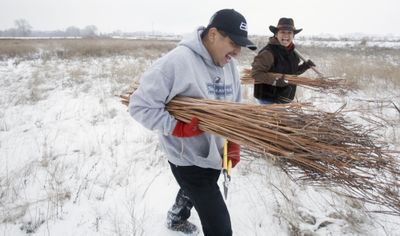Yakama work to keep native plants, uses alive

TOPPENISH, Wash. – Lavina Wilkins grew up gathering various berries and other native plants along the Yakima River.
Raised by her grandmother in the Parker area, the Yakama tribal member learned firsthand the inseparable link between the land and her people.
“The Creator provided us everything we needed to survive,” says Wilkins, now a tribal elder and manager of the Yakama Nation’s language program. “We have made use of all these things.”
For countless generations, the Yakamas have used various native plants for food, medicine, tools and shelter – even to bury their dead.
But over the past 150 years, sprawling hops fields, apple orchards and vineyards have chiseled away at the 1.2 million-acre reservation, encroaching on the habitat of many native plants.
Some plants were entirely wiped out. Others, such as dogbane, black currant and large sage, continue to experience smaller yields each year.
“Farming has hurt a lot,” Wilkins says. “But the farmers don’t realize it because no one (publicly) upholds the value of what we’re doing.”
Although much traditional food and medicine are still gathered from plants, many tribal members have lost touch with other natural foliage and their uses.
Now, Wilkins and a handful of other Yakamas in her native language department have embarked on an effort to save diminishing native plants that are integral to their culture.
Recently, the group began gathering dogbane – a weedlike plant used to make twine, rope and medicine. The group’s members are now teaching a class on how to spool it into twine.
“Everything has a reason, and we’re slowly losing everything,” says Wilkins, her graying hair pulled into a barrette, with small woven basket earrings dangling from her earlobes. “That’s why me and my staff are trying to preserve and teach our younger generations.”
Standing in nearly a half-foot of snow in a field just west of Toppenish, HollyAnna Pinkham snaps small branches from a long dogbane stem.
She piles the stems while leaving the smaller branches with seed pods at their ends on the ground.
“We don’t take everything,” she says. “You have to leave something so it will grow again.”
Farmers often destroy dogbane because of its weedlike properties and toxicity. But the Yakama use it to treat heart problems, poison ivy and other ailments. They harvest it in winter, when the plant takes on a reddish color.
Christopher Paul Jr. works with Pinkham to harvest dogbane. He grips the handles of his loppers and cuts dogbane stems at their base.
A few years ago, he helped the Wanapums build their tule-mat longhouse, a tribal church, near the Wanapum Dam on the Columbia River. Now, he and his wife, Martha, are teaching the art of making twine from dogbane.
“When my kids get older, I’m going to teach them the same way,” he said of his five young sons.